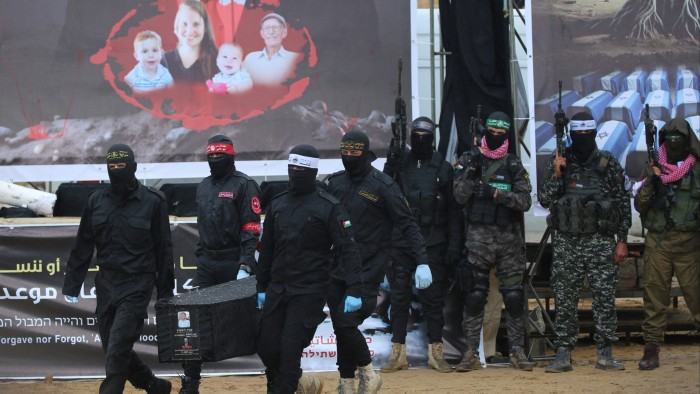Israel said Hamas had violated a shaky ceasefire, after forensics tests found the fourth body released on Thursday morning was not of an Israeli hostage but rather an “anonymous, unidentified body”.
Hamas was supposed to have handed over the remains of four Israeli hostages, including two children, in a grim exchange that initially signalled progress for the shaky ceasefire agreement.
The Israeli military quickly confirmed one of the bodies was that of 83-year-old peace activist Oded Lifschitz.
But in a statement early on Friday morning, the military said that while it had confirmed two of the other coffins contained the remains of two brothers — Kfir, an infant, and Ariel, 4, at the time they were taken hostage — the last body was not that of their 32-year-old mother, Shiri Bibas.
“This is a violation of utmost severity by the Hamas terrorist organisation, which is obligated under the agreement to return four deceased hostages,” the Israel Defense Forces said. “We demand that Hamas return Shiri home along with all our hostages.”
The International Committee of the Red Cross had transported the four coffins early in the morning from Gaza, but the Bibas family, in particular, had requested that the media not jump to conclusions about the fate of their loved ones until the military was done with its forensic tests.
The revelation that Hamas may have swapped out the remains of a hostage with an unknown body will stress a fragile ceasefire.
As the bodies were taken for identification, Israel’s President Isaac Herzog begged the families and the dead for forgiveness.
“I bow my head and ask for forgiveness,” he said. “Forgiveness for not protecting you on that terrible day. Forgiveness for not bringing you home safely.”
Israel is supposed to release hundreds more Palestinian prisoners in exchange as required by the ceasefire agreement.
Hamas has pledged to release six living hostages ahead of schedule on Saturday, in hopes of buttressing negotiations aimed at converting the temporary ceasefire into a lasting truce. Dozens of hostages, alive and dead, remain in captivity in Gaza.
In Israel the capture of the Bibas family — the children’s father was released alive in February in the first stage of the exchanges — has become a symbol of Hamas’s brutality in the October 7 2023 attack that triggered the war in Gaza.
They are also emblematic of the failures of the Israeli military that day, with the army failing to reach the Nir Oz kibbutz until long after Hamas’s fighters had escaped back into Gaza with 80 hostages, having killed dozens in the remote village.
In a propaganda video released by Hamas, Shiri carried the children in her arms as armed fighters seized them. Pictures of the smiling, red-haired children have become ubiquitous on Israeli posters demanding the release of hostages.
The circumstances around the Bibas’s deaths remain uncertain. Hamas has said they were killed in an Israeli air strike, without providing evidence.

The militant group repeated that assertion on Thursday, handing over the bodies to the Red Cross under a sign that blamed Israeli Prime Minister Benjamin Netanyahu and “missiles from Zionist warplanes” for their deaths.
The IDF had not commented on their case until Friday, when it said the two children and Lifschitz “were brutally murdered by terrorists in captivity.”
Lifschitz and his wife, Yocheved, were also taken from their homes near the Bibas family. Yocheved was released 16 days into the war.
A handful of families have been informed that their loved ones may have been killed inadvertently by its bombardment of Gaza, according to interviews in Israeli media.
Officials in Gaza estimate about 50,000 Palestinians, mostly women and children, have been killed by the Israeli assault, which has destroyed most of the besieged enclave. About 1,200 people were killed in Israel in Hamas’s cross-border raid and some 250 were taken hostage, according to Israeli officials.
The release on Thursday was the first of deceased hostages and came in the fifth week of a six-week ceasefire agreed last month, under which Israel has released 985 Palestinian prisoners in exchange for 19 living Israeli hostages, according to the Red Cross.
The vast majority of the Palestinians had been detained in Israel without trial, while dozens were serving life sentences after being convicted in military prisons for killing Israelis.
After sharply controlling the entry of aid into Gaza for the 15 months of war, Israel’s military has allowed thousands of trucks with humanitarian aid into Gaza since the ceasefire went into effect, including a small amount of heavy machinery, and mobile homes starting this week.
Negotiations between Israel and Hamas aimed at securing a lasting truce have begun in Cairo, mediated by Egypt, Qatar and the US. But a deal would require Israel to withdraw its army from Gaza and Hamas to release the remaining 60 or so hostages, many of whom are feared dead.
Netanyahu’s ruling coalition depends on the support of a far-right political party that is bitterly opposed to the ceasefire and has vowed to resume the assault on Hamas.
The militant group appeared to threaten the living hostages during Thursday’s handover, displaying a sign that read: “The Return of War = The Return of Your Prisoners in Coffins.”
Hamas is known to have executed at least six prisoners last year after suspecting an Israeli rescue operation in the tunnels where they were held.
The IDF said at the time no such operation was ongoing and it had stumbled on the recently killed hostages on a regular patrol.







